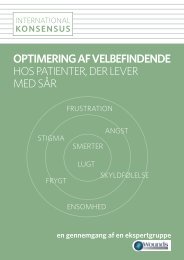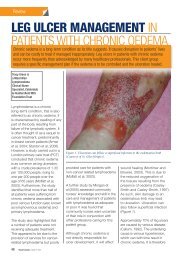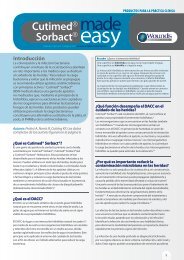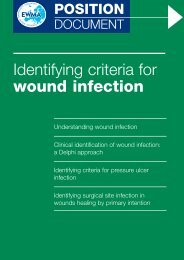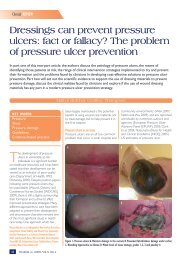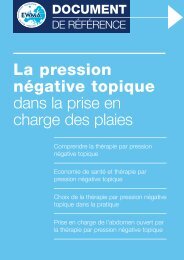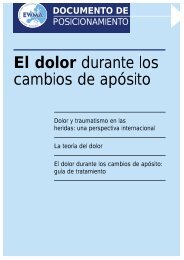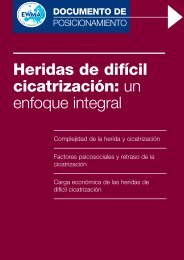A multinational survey of the assessment of pain when removing ...
A multinational survey of the assessment of pain when removing ...
A multinational survey of the assessment of pain when removing ...
Create successful ePaper yourself
Turn your PDF publications into a flip-book with our unique Google optimized e-Paper software.
Kennen Sie Russland wirklich?ERWERBINTERKULTURELLERKOMPETENZENZU VIETNAM, RUSSLANDUND POLENHerzlich Willkommen!21. – 22. September 201126. – 27. Oktober 201102. – 03. November 201123. – 24. November 2011
Clinical RESEARCH/AUDITPercentage <strong>of</strong> <strong>survey</strong> population≤ 60 61–70 71–80 81–90 ≥ 90 No answerAge group (years)Figure 1. Age demographics <strong>of</strong> <strong>survey</strong> population.7%31%14%1%25%13%4%5%Figure 2. Wound types included in <strong>the</strong> <strong>survey</strong>.Adhesive foams0Venous leg ulcer (or mixed)BurnArterial leg ulcerSkin tearPressure ulcerDiabetic foot ulcerO<strong>the</strong>rNo answerNumber <strong>of</strong> patients200 400 600 800 1000 1200 1400 16001445no trauma associated with <strong>the</strong> dressingsutilising Safetac technology.Evaluation <strong>of</strong> <strong>pain</strong>Data relating to <strong>pain</strong> (before, during andafter dressing removal) associated with <strong>the</strong>traditional adhesive-based dressings at visit1 compared with that associated with <strong>the</strong>dressings utilising Safetac technology at visit2 are presented in Figure 5.The results from this study show thatat visit 1 <strong>the</strong> ranges <strong>of</strong> VAS <strong>pain</strong> scoresreported with <strong>the</strong> traditional adhesivebaseddressings were:8 Before removal <strong>of</strong> <strong>the</strong> dressings:2.4–3.28 At <strong>the</strong> time <strong>of</strong> <strong>the</strong> dressing changes:4.6–5.28 After dressing changes: 2.9–3.9.It was evident that <strong>the</strong>re was aconsistent trend associated with all <strong>of</strong><strong>the</strong> traditional adhesive-based dressingsevaluated where <strong>pain</strong> levels increasedduring <strong>the</strong>ir removal.In comparison, signifi cantly lower<strong>pain</strong> scores (p=0.01) were reportedat visit 2 after <strong>the</strong> patients had beentreated with <strong>the</strong> dressings utilisingSafetac technology compared with thosereported at visit 1 after <strong>the</strong> patients hadbeen treated with traditional adhesivebaseddressings (Table 3).HydrocolloidsO<strong>the</strong>r dressings4951095The ranges <strong>of</strong> VAS <strong>pain</strong> scores at visit2 were:8 Before removal <strong>of</strong> <strong>the</strong> dressings:1.7–1.88 At <strong>the</strong> time <strong>of</strong> <strong>the</strong> dressing changes:2.1–2.28 After dressing changes: 1.6–1.7.Figure 3. Advanced dressings with traditional adhesives used at baseline.and o<strong>the</strong>r dressings (n=495) such as fi lms,surgical dressings and alginates.Evaluation <strong>of</strong> traumaData relating to trauma associated with<strong>the</strong> traditional adhesive-based dressingsat visit 1 compared with that associatedwith <strong>the</strong> dressings utilising Safetactechnology at visit 2 are presented inFigure 4. The results at visit 1 demonstratethat about 10% <strong>of</strong> responses indicatedhigh levels <strong>of</strong> trauma; 28–39% <strong>of</strong> <strong>the</strong>responses indicated moderate levels;31–35% indicated very slight trauma;and 18–29% indicated no traumaassociated with <strong>the</strong> traditional adhesivebaseddressings. In comparison, <strong>the</strong>results at visit 2 demonstrate that only1% <strong>of</strong> responses indicated high levels <strong>of</strong>trauma; 11% <strong>of</strong> <strong>the</strong> responses indicatedmoderate levels; 35–37% indicated veryslight trauma, and about 50% indicatedUnlike <strong>the</strong> traditional adhesive-baseddressings, <strong>the</strong> dressings with Safetactechnology were not associated withincreased <strong>pain</strong> at dressing changes. The<strong>pain</strong> scores at visit 2 remained low andconsistent throughout <strong>the</strong> dressingchanges.When asked about dressingpreference, more than 90% <strong>of</strong> patients<strong>survey</strong>ed indicated that <strong>the</strong>y preferred <strong>the</strong>dressings with Safetac technology to <strong>the</strong>irprevious dressing regimen (Figure 6).16 Wounds UK , 2008, Vol 4, No 1
Clinical RESEARCH/AUDITProportion <strong>of</strong> patientsAdhesive foams Hydrocolloids O<strong>the</strong>r dressings Mepilex (Lite) Mepilex Border (Lite)18 172950 4935 35 37 393633312812 11 11 11 9No Very slight Moderate HighDressingsFigure 4. Trauma scores at visit 1 (wounds treated with advanced dressings with traditional adhesives)compared with those obtained at visit 2 (wounds treated with foam dressings with Safetac s<strong>of</strong>t siliconeadhesive technology).Pain scores (VAS)3.25.23.93.15.13.6Adhesive foams Hydrocolloids O<strong>the</strong>r dressings Mepilex (Lite) Mepilex Border (Lite)DressingsFigure 5. Pain scores at visit 1 (wounds treated with advanced dressings with traditional adhesives)compared with those obtained at visit 2 (wounds treated with foam dressings with Safetac s<strong>of</strong>t siliconeadhesive technology) before, during and after dressing removal.TotalMepilex Lite0%43Mepilex Border Lite 4Prefer previous dressingFigure 6. Preferred dressing use after completion <strong>of</strong> <strong>survey</strong>.2.44.62.91.8 2.1 1.61.71 1Before During AfterPrefer a Mepilex dressing2.21.720% 40% 60% 80% 100%93 394 393 3No answerand sometimes aggressive adhesiveson dressings has been shown to causedamage to <strong>the</strong> newly forming wound bedand/or adjacent peri-wound skin, and <strong>the</strong>damage caused by repeated applicationand removal <strong>of</strong> adhesive dressings is <strong>the</strong>main cause <strong>of</strong> trauma to wounds andperi-wound skin (Dykes et al, 2001; Dykesand Heggie, 2003; Dykes, 2007).This trauma can give rise to variablelevels <strong>of</strong> infl ammatory skin damage— oedema, soreness and adverse effectson skin barrier function (Gerritsen et al,1994; Dykes and Heggie, 2003; Dykes,2007). In a series <strong>of</strong> studies, Dykes hasshown that some traditional adhesivebaseddressings which use acrylic-basedadhesives can be more aggressive thano<strong>the</strong>rs using Safetac s<strong>of</strong>t silicone adhesivetechnology. When applied to <strong>the</strong> skin <strong>of</strong>volunteers with healthy skin it has beenshown that traditional adhesive-baseddressings demonstrate a greater degree <strong>of</strong>damage to <strong>the</strong> stratum corneum (Dykeset al, 2001), higher levels <strong>of</strong> discomfort(Dykes and Heggie, 2003) and skindamage as measured by transepidermalwater loss (TEWL) with greaterdiscomfort measured using a cumulativeirritancy score (Dykes, 2007). With <strong>the</strong>physical trauma caused to <strong>the</strong> wound andskin, it has been suggested that patientssuffer stress as a result <strong>of</strong> <strong>pain</strong> relatedto dressings and dressing changes whichmay in turn be detrimental to <strong>the</strong> healingprocess (Soon and Acton, 2006; Coulling,2007; Vileikyte, 2007).A fur<strong>the</strong>r problem associated withtraditional adhesive-based dressings is <strong>pain</strong>resulting from <strong>the</strong> damage that <strong>the</strong>y cancause to wounds and peri-wound skin.Pain is a major problem and is most <strong>of</strong>tenrelated to inappropriate dressing selection.The selection <strong>of</strong> a suitable, non-adherentdressing which will result in greater patientacceptability is a very important part<strong>of</strong> <strong>the</strong> holistic approach to treatment(Meaume et al, 2004).DiscussionThere are a number <strong>of</strong> criteria that havebeen listed as necessary to create anoptimum wound dressing (Dale, 1997;Morgan, 1998) but essentially a dressingshould provide protection for <strong>the</strong>wound and an optimum environment18 Wounds UK , 2008, Vol 4, No 1for healing, but above all it must notcause any fur<strong>the</strong>r damage or sufferingto <strong>the</strong> patient. Unfortunately, whilemany dressings go some way to fulfi lling<strong>the</strong>se criteria, many <strong>of</strong> <strong>the</strong>m can causefur<strong>the</strong>r trauma and subsequent <strong>pain</strong> for<strong>the</strong> patient. The use <strong>of</strong> inappropriateA number <strong>of</strong> studies have lookedat <strong>the</strong> impact <strong>of</strong> <strong>pain</strong> in patients with avariety <strong>of</strong> different wounds. In a largestudy undertaken to evaluate <strong>the</strong>incidence <strong>of</strong> <strong>pain</strong> in 5,850 patients withacute (n=2,914) or chronic wounds(n=2,936) <strong>of</strong> various causes during
Clinical RESEARCH/AUDITTable 3Statistical analysis <strong>of</strong> <strong>pain</strong> scores: traditional adhesive-based dressings versus dressingswith Safetac technology’ParameterAverage <strong>pain</strong> scores(VAS) (n=3,034)Before removal: first visit (advanced dressings utilising traditional adhesives) 3.0Before removal: second visit (dressing with Safetac technology) 1.8Difference -1.2SignificanceP=0.01At removal: first visit (advanced dressings utilising traditional adhesives) 5.1At removal: second visit (dressing with Safetac technology) 2.2Difference -2.9Significance P = 0.01After removal: first visit (advanced dressings utilising traditional adhesives) 3.6After removal: second visit (dressing with Safetac technology) 1.7Difference -1.9SignificanceP=0.01dressing removal, and to evaluate <strong>the</strong>effect <strong>of</strong> switching to a non-adherentdressing, patients with both types <strong>of</strong>wounds reported ‘moderate to severe’<strong>pain</strong> during <strong>the</strong> medical screening visit(79.9% and 79.7%) and ‘very severe’<strong>pain</strong> in <strong>the</strong>ir self-evaluation questionnairecompleted at home (47% and 59%respectively) (Meaume et al, 2004).Dressing removal was found to be most<strong>pain</strong>ful <strong>when</strong> <strong>the</strong>re was adherence to<strong>the</strong> wound bed. Switching to a new, nonadherentdressing reduced <strong>pain</strong> duringdressing changes in 88% <strong>of</strong> patients withchronic wounds and 95% <strong>of</strong> patients withacute wounds.A recent one-day <strong>survey</strong> wasundertaken at a university hospital inParis, France. The purpose <strong>of</strong> <strong>the</strong> studywas to evaluate <strong>the</strong> prevalence, clinicalaspects and management <strong>of</strong> wounds in <strong>the</strong>hospital by undertaking a ‘snapshot’ <strong>survey</strong><strong>of</strong> all hospitalised patients to ascertain <strong>the</strong>prevalence <strong>of</strong> wounds and <strong>the</strong> provision<strong>of</strong> wound care on one specific day inApril 2005. The results demonstrated that,out <strong>of</strong> a total <strong>of</strong> 624 patients examined,327 (52%) had 933 wounds (an average<strong>of</strong> 2.8 per patient). Importantly, <strong>pain</strong> atwound dressing changes was treatedin 89% <strong>of</strong> cases (Mahé et al, 2006). Thefindings <strong>of</strong> Mahé et al highlight that <strong>pain</strong>at wound dressing change is endemic and,fur<strong>the</strong>rmore, <strong>of</strong>ten requires a treatmentintervention, thus emphasising <strong>the</strong> need forappropriate dressing usage and dressingchange procedures.A recently published article hashighlighted <strong>the</strong> fact that a high percentage(60%) <strong>of</strong> patients with venous leg ulcersand o<strong>the</strong>r types <strong>of</strong> chronic wounds exhibit<strong>pain</strong>, <strong>the</strong> result <strong>of</strong> which is detrimentalto <strong>the</strong> well-being <strong>of</strong> patients (Price etal, 2007) and can delay healing (Soonand Acton, 2006). Price et al underline<strong>the</strong> message that <strong>pain</strong> and its causeshould be handled as one <strong>of</strong> <strong>the</strong> mainpriorities in chronic wound management,that <strong>assessment</strong> should be undertakenroutinely, and if this is not done <strong>the</strong>n itwill lead to patient suffering and increasedcosts to healthcare service providers (Priceet al, 2007).Pain associated with trauma can, insome instances, be considerable, notably<strong>when</strong> dressings are changed, and is aconcern in patients with chronic wounds(e.g. venous leg ulcers) and friable periwoundskin. As a consequence, <strong>pain</strong>management has become a major part<strong>of</strong> wound care with many organisationsand care providers incorporating <strong>the</strong>management <strong>of</strong> wound <strong>pain</strong> into standardsand guidelines. The European WoundManagement Association (EWMA)has developed a position documentthat provides clinical recommendationson how to assess and manage wound<strong>pain</strong> (European Wound ManagementAssociation, 2002).The results from this large<strong>multinational</strong> clinical <strong>survey</strong> demonstratethat foam dressings with Safetac s<strong>of</strong>tsilicone adhesive, <strong>when</strong> used in <strong>the</strong> place<strong>of</strong> some types <strong>of</strong> adhesive foams andhydrocolloids, reduce traumatic injuriesto <strong>the</strong> wound or adjacent tissue. Theintroduction <strong>of</strong> dressings with Safetactechnology resulted in a reduction in <strong>the</strong>levels <strong>of</strong> trauma compared with thosereported with <strong>the</strong> advanced dressingsutilising traditional adhesive systems. Forexample, <strong>the</strong> percentage <strong>of</strong> responsesindicating no trauma with <strong>the</strong> dressingsutilising Safetac technology was almostdouble that recorded for <strong>the</strong> advanceddressings with traditional adhesives.The findings also demonstrate that <strong>the</strong>dressings are associated with clinicallysignificant reductions in levels <strong>of</strong> woundassociated<strong>pain</strong> at dressing changes. Thelow <strong>pain</strong> scores recorded immediatelybefore dressing change reflect <strong>the</strong> lowlevels <strong>of</strong> <strong>pain</strong> associated with foamdressings using Safetac s<strong>of</strong>t siliconetechnology during wear, even though <strong>the</strong>scores could have been influenced bypatients anticipating possible effects <strong>of</strong> <strong>the</strong>imminent dressing removals.The <strong>pain</strong> scores in this <strong>multinational</strong><strong>survey</strong> seem relatively low <strong>when</strong> comparedwith <strong>pain</strong> scores from patients with woundsreported in <strong>the</strong> published literature. Forexample, in a study that was undertaken toevaluate <strong>the</strong> application <strong>of</strong> a topical collagenmatrix to patients with venous leg ulcers(Wollina et al, 2005), one <strong>of</strong> <strong>the</strong> objectiveswas to measure <strong>pain</strong> associated with <strong>the</strong>wound. The mean VAS <strong>pain</strong> scores beforetreatment were reported to be 8.72 and7.88, for <strong>the</strong> treatment and non-treatmentgroups respectively. After one week <strong>of</strong>treatment, <strong>the</strong> scores dropped to 5.76 and6.66, although <strong>the</strong> treated group did showa reduction in <strong>pain</strong> scores to 3.84 in <strong>the</strong>second week <strong>of</strong> treatment. Overall <strong>the</strong>scores were notably higher than seen in<strong>the</strong> <strong>multinational</strong> <strong>survey</strong> presented in thisarticle. Ano<strong>the</strong>r study investigated <strong>pain</strong> as20 Wounds UK , 2008, Vol 4, No 1
Clinical RESEARCH/AUDITmeasured by VAS in patients with skin graftsites treated with three different dressings(Poonyakariyagorn et al, 2002). The <strong>pain</strong>scores associated with two film dressingswere comparable to those obtainedin this <strong>survey</strong>, whereas <strong>the</strong> <strong>pain</strong> scoresassociated with a tulle gauze dressing weremuch higher. The low <strong>pain</strong> scores may beexplained, at least in part, by <strong>the</strong> fact that<strong>the</strong> patients reported <strong>the</strong>ir <strong>pain</strong> scores to<strong>the</strong> investigators who actually undertook<strong>the</strong> dressing changes, although this practiceis in line with <strong>the</strong> recommendations <strong>of</strong> <strong>the</strong>World Union <strong>of</strong> Wound Healing Societiesin relation to <strong>pain</strong> <strong>assessment</strong> (WUWHS,2004).Pain scores are also related to <strong>the</strong>wound type: some wounds are more<strong>pain</strong>ful than o<strong>the</strong>rs, and some woundsmay present with little or no <strong>pain</strong>. It might<strong>the</strong>refore be appropriate to group thisdata according to wound type in order toobtain a more detailed view <strong>of</strong> <strong>the</strong> ability<strong>of</strong> foam dressings with Safetac s<strong>of</strong>t siliconeadhesive technology to reduce <strong>pain</strong>.ConclusionTrauma to wounds or peri-wound skinmay exacerbate <strong>the</strong> condition leadingto delayed healing or fur<strong>the</strong>r woundcomplications. Pain leading to increasedstress in patients has also been implicatedin contributing to a delayed healingresponse. In view <strong>of</strong> this, <strong>the</strong> use <strong>of</strong>dressings that do not cause trauma and<strong>pain</strong> present obvious benefits to patientsas well as clinical benefits by having <strong>the</strong>potential to shorten healing times whichultimately makes better use <strong>of</strong> <strong>the</strong> limitedresources available to health workerstreating chronic wounds.The results <strong>of</strong> this <strong>survey</strong> demonstratethat dressings that include Safetac s<strong>of</strong>tsilicone adhesive technology benefitpatients in terms <strong>of</strong> significantly reducing<strong>pain</strong> during wear (as indicated by <strong>the</strong><strong>pain</strong> scores recorded immediately beforedressing change), at dressing removal, andafter dressing change, <strong>when</strong> comparedwith advanced dressings that usetraditional adhesives. WUKReferencesActon C (2007) The holistic management <strong>of</strong>chronic wound <strong>pain</strong>. Wounds UK 3(1): 61–922 Wounds UK , 2008, Vol 4, No 1Coulling S (2007) Fundamentals <strong>of</strong> <strong>pain</strong>management in wound care. Br J Nurs 16(13):S4–S12Dale J (1997) Wound dressings. Pr<strong>of</strong> Nurse 12(Suppl): S12–S14Dykes PJ (2007) The effect <strong>of</strong> adhesive dressingedges on cutaneous irritancy and skin barrierfunction. J Wound Care 16(3): 97–100Dykes PJ, Heggie R, Hill SA (2001) Effects <strong>of</strong>adhesive dressings on <strong>the</strong> stratum corneum <strong>of</strong>skin. J Wound Care 10(2): 7–10Dykes PJ, Heggie R (2003) The link between<strong>the</strong> peel force <strong>of</strong> adhesive dressings andsubjective discomfort in volunteer subjects. JWound Care 12(7): 260–2European Wound Management Association(2002) Position Document: Pain at WoundDressing Changes. Medical EducationPartnership Ltd, LondonFranks PJ, Moody M, M<strong>of</strong>fatt CJ, Hiskett G,Gatto P, Davies C, Furlong WT et al (2007)Randomized trial <strong>of</strong> two foam dressings in <strong>the</strong>management <strong>of</strong> chronic venous ulceration.Wound Repair Regen 15(2): 197–202Freeman K, Smyth C, Dallam L, JacksonB (2001) Pain measurement scales: acomparison <strong>of</strong> <strong>the</strong> visual analogue and facesrating scales in measuring pressure ulcer <strong>pain</strong>.J Wound Ostomy Cont Nurs 28(6): 290–6Gerritsen MJ, van Erp PE, van Vlijmen-WillemsIM, et al (1994) Repeated tape stripping <strong>of</strong>normal skin: a histological <strong>assessment</strong> andcomparison with events seen in psoriasis. ArchDermatol Res 286(8): 455–61Harms-Ringdahl K, Carlsson AM, Ekholm J,Raustorp A, Svensson T, Toresson HG (1986)Pain <strong>assessment</strong> with different intensity scales inresponse to loading <strong>of</strong> joint structures. Pain 27:401–11Mahé E, Langlois G, Baron G, et al (2006)Results <strong>of</strong> a comprehensive hospital-basedwound <strong>survey</strong>. J Wound Care 15(9): 381–4Meaume S, Teot L, Lazareth I, Martini J, BohbotS (2004) The importance <strong>of</strong> <strong>pain</strong> reductionthrough dressing selection in routine woundmanagement: <strong>the</strong> MAPP study. J Wound Care13(10): 409–13Morgan DA (1998) The application <strong>of</strong> <strong>the</strong> ‘idealdressing’ <strong>the</strong>ory to practice. Nursing ScotlandJuly: 16–8Poonyakariyagorn T, Sirimaharaj W, Pinchai O,Angspatt A (2002) Comparison among Op-site,polyvinyl chloride film and tulle gauze in <strong>the</strong>treatment <strong>of</strong> skin graft donor site. J Med AssocThai 85(4): 455–61Price P, Fogh K, Glynn C, Krasner DL,Osterbrink J, Sibbald RG (2007) Managing<strong>pain</strong>ful chronic wounds: <strong>the</strong> wound <strong>pain</strong>Management Model. Int Wound J 4(S1): 4–15Soon K, Acton C (2006) Pain-inducedstress: a barrier to wound healing. WoundsKey Points8 Repeated application and removal<strong>of</strong> many adhesive dressings canresult in trauma to wounds andperi-wound skin.8 A large, <strong>multinational</strong> <strong>survey</strong> wasundertaken to assess <strong>the</strong> impact<strong>of</strong> introducing advanced dressingswith s<strong>of</strong>t silicone adhesivetechnology on levels <strong>of</strong> woundtrauma and <strong>pain</strong> associated withdressing application and removal,compared to a previous regimen<strong>of</strong> using advanced dressings withtraditional adhesives.8 S<strong>of</strong>t silicone dressings, <strong>when</strong> usedin <strong>the</strong> place <strong>of</strong> some traditionaladhesive-based dressings, reducedtraumatic injuries relating to<strong>the</strong> wound or adjacent skin andsignificantly reduced levels <strong>of</strong> <strong>pain</strong>at dressing change.8 The very low <strong>pain</strong> scoresrecorded immediately beforedressing change reflect <strong>the</strong> lowlevels <strong>of</strong> <strong>pain</strong> associated with s<strong>of</strong>tsilicone dressings during wear.8 The use <strong>of</strong> dressings that do notcause trauma and <strong>pain</strong> presentobvious benefits to patients.UK 2(4): 92–101Tokumura F, Umekage K, Sado M, et al (2005)Skin irritation due to repetitive application<strong>of</strong> adhesive tape: <strong>the</strong> influence <strong>of</strong> adhesivestrength and seasonal variability. Skin ResTechnol 11(2): 102–6Vileikyte L (2007) Stress and wound healing.Clin Dermatol 25(1): 49–55White R (2005) Evidence for atraumatic s<strong>of</strong>tsilicone wound dressing use. Wounds UK 1(3):104–9Wollina U, Schmidt WD, Krönert C, NelskampC, Scheibe A, Fassler D (2005) Some effects<strong>of</strong> a topical collagen-based matrix on <strong>the</strong>microcirculation and wound healing in patientswith chronic venous leg ulcers: preliminaryobservations. Int J Low Extrem Wounds 4(4):214–24World Union <strong>of</strong> Wound Healing Societies (2004)Principles <strong>of</strong> best practice: minimising <strong>pain</strong> atwound dressing-related procedures. A consensusdocument. http://www.wuwhs.org/pdf/consensus_eng.pdf Last accessed 20th August 2007




